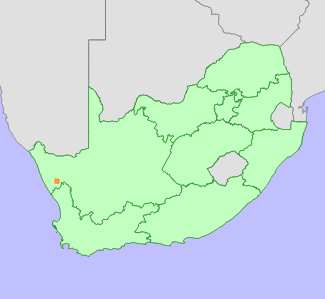|
Scientific Name | Metalasia namaquana P.O.Karis & N.A.Helme |
Higher Classification | Dicotyledons |
Family | ASTERACEAE |
National Status |
Status and Criteria | Rare |
Assessment Date | 2014/05/20 |
Assessor(s) | N.A. Helme & L. von Staden |
Justification | A localized habitat specialist (EOO <10 km²), but not threatened. |
Distribution |
Endemism | South African endemic |
Provincial distribution | Northern Cape |
Range | Rooiberg and Stalberg in the Kamiesberg Mountains. |
Habitat and Ecology |
Major system | Terrestrial |
Major habitats | Kamiesberg Granite Fynbos |
Description | Shallow, rocky soils among large granite boulders on north-south trending ridges, 1200-1500 m. |
Threats |
| The population occurs on privately owned land that is used predominantly for grazing, but it is not heavily grazed and grazing does not appear to have an impact on the population (Karis and Helme 2012). |
Population |
This species is known from a single, localized subpopulation of between 2000 and 6000 mature individuals, covering an area of no more than 600 ha (Karis and Helme 2012).
|
Population trend | Stable |
Assessment History |
Taxon assessed |
Status and Criteria |
Citation/Red List version | | Metalasia namaquana P.O.Karis & N.A.Helme | Rare | 2014.1 | |
Bibliography |
Karis, P.O. and Helme, N.A. 2012. Metalasia namaquana (Asteraceae-Gnaphalieae), a new species from the Kamiesberg (South Africa). South African Journal of Botany 78:281-284.
|
Citation |
| Helme, N.A. & von Staden, L. 2014. Metalasia namaquana P.O.Karis & N.A.Helme. National Assessment: Red List of South African Plants version 2024.1. Accessed on 2025/11/30 |
 Comment on this assessment
Comment on this assessment


